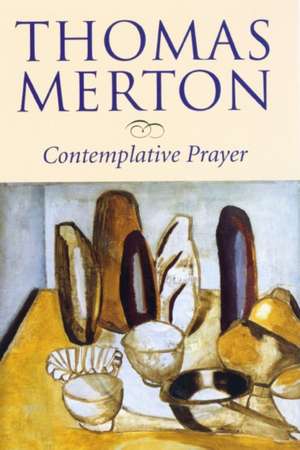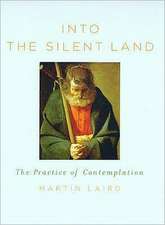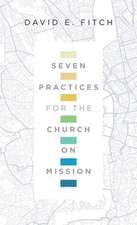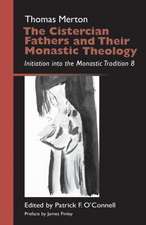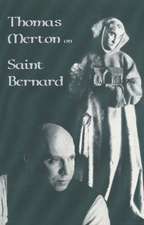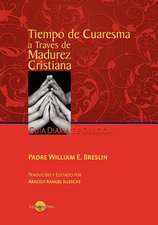Contemplative Prayer
Autor Thomas Mertonen Limba Engleză Paperback – 23 mai 2005
| Toate formatele și edițiile | Preț | Express |
|---|---|---|
| Paperback (2) | 62.63 lei 3-5 săpt. | +5.95 lei 7-13 zile |
| DARTON LONGMAN & TODD LTD – 23 mai 2005 | 62.63 lei 3-5 săpt. | +5.95 lei 7-13 zile |
| IMAGE – 31 ian 1971 | 82.49 lei 3-5 săpt. |
Preț: 62.63 lei
Nou
Puncte Express: 94
Preț estimativ în valută:
11.99€ • 12.42$ • 10.00£
11.99€ • 12.42$ • 10.00£
Carte disponibilă
Livrare economică 28 februarie-14 martie
Livrare express 14-20 februarie pentru 15.94 lei
Preluare comenzi: 021 569.72.76
Specificații
ISBN-13: 9780232526042
ISBN-10: 0232526044
Pagini: 144
Dimensiuni: 121 x 193 x 13 mm
Greutate: 0.14 kg
Ediția:UK ed
Editura: DARTON LONGMAN & TODD LTD
Locul publicării:United Kingdom
ISBN-10: 0232526044
Pagini: 144
Dimensiuni: 121 x 193 x 13 mm
Greutate: 0.14 kg
Ediția:UK ed
Editura: DARTON LONGMAN & TODD LTD
Locul publicării:United Kingdom
Notă biografică
THOMAS MERTON (1915-1968), Trappist monk, author, and peace activist, came to international prominence at a young age with his classic autobiography, The Seven Story Mountain. Over the rest of his life he wrote prolifically on a vast range of topics, including prayer, interior growth, social responsibility, violence, and war. Toward the end of his life he played a significant role in introducing Eastern religions to the West. He is today regarded as a spiritual master, a brilliant religious writer, and a man who embodied the quest for God and human solidarity in the modern world.
THICH NHAT HANH is an internationally respected Zen poet and teacher. He is the author of numerous bestselling books, including Zen Keys and Living Buddha Living Christ.
THICH NHAT HANH is an internationally respected Zen poet and teacher. He is the author of numerous bestselling books, including Zen Keys and Living Buddha Living Christ.
Extras
Contemplative Prayer
I
The climate in which monastic prayer flowers is that of the desert,9 where the comfort of man is absent, where the secure routines of man’s city offer no support, and where prayer must be sustained by God in the purity of faith. Even though he may live in a community, the monk is bound to explore the inner waste of his own being as a solitary. The Word of God which is his comfort is also his distress. The liturgy, which is his joy and which reveals to him the glory of God, cannot fill a heart that has not previously been humbled and emptied by dread. Alleluia is the song of the desert.
The Christian (even though he be a monk or a hermit) is never merely an isolated individual. He is a member of the praising community, the People of God. Alleluia is the victorious acclamation of the Risen Savior. Yet the People of God itself, while celebrating the praise of the Lord in a tabernacle of beauty overshadowed by the Bright Cloud of his presence, is still on pilgrimage. We acclaim God as members of a community that has been blessed and saved and is traveling to meet him as he comes in his promised Advent. Yet as individuals we know ourselves to be sinners. The prayer of the monk is dictated by this twofold consciousness of sin and redemption, wrath and mercy—as is the prayer of every Christian. But the monk is called to explore these two dimensions more thoroughly, and at greater cost, than his brothers who are devoted to works of mercy, or of creativity in the world.
In this study we are going to concern ourselves particularly with personal prayer, especially in its meditative and contemplative aspects. It is understood that the personal prayer of the monk is embedded in a life of psalmody, liturgical celebration and the meditative reading of Scripture (lectio divina). All this has both a personal and a communal dimension. We are concerned here most of all with the monk’s own deepening existential grasp of his call to life in Christ, as it progressively reveals itself to him in the solitude where he is alone with God—whether or not his brothers may be physically present around him.
Dostoievski, in The Brothers Karamazov, shows us what Rozanov has called an “eternal conflict” in monasticism—and doubtless in Christianity itself. Th e conflict between the rigid, authoritarian, self-righteous, ascetic Therapont, who delivers himself from the world by sheer effort, and then feels qualified to call down curses upon it; and the Staretz, Zossima, the kind, compassionate man of prayer who identifies himself with the sinful and suffering world in order to call down God’s blessing upon it.
It must be emphasized that in the present era of monastic renewal we are more and more concerned with the Zossima type. And this kind of monastic spirit is charismatic rather than institutional. It has much less need of rigid structures and is totally abandoned to one need alone: that of obedience to the word and spirit of God, tested by fruits of humility and compassionate love. Thus the Zossima type of monasticism can well flourish in off beat situations, even in the midst of the world. Perhaps such “monks” may have no overt monastic connections whatever.
On the other hand, it must be admitted that communal structures have a value that must not be underestimated. The order, the quiet, the fraternal communication and love provided by a working and praying community are the obvious and ordinary place in which the life of prayer develops. Needless to say, such communities do not have to reproduce only the regular and observant patterns of Trappist, Carthusian or Carmelite convent life as we have known them hitherto.
II
In the way of prayer, as described by the early monastic writers, meditatio must be seen in its close relation to psalmodia, lectio, oratio and contemplatio. It is part of a continuous whole, the entire unified life of the monk, conversatio monastica, his turning from the world to God. To separate meditation from prayer, reading and contemplation is to falsify our picture of the monastic way of prayer. In proportion as meditation takes on a more contemplative character, we see that it is not only a means to an end, but also has something of the nature of an end. Hence monastic prayer, especially meditation and contemplative prayer, is not so much a way to fi nd God as a way of resting in him whom we have found, who loves us, who is near to us, who comes to us to draw us to himself. Dominus enim prope est. Prayer, reading, meditation and contemplation fill the apparent “void” of monastic solitude and silence with the reality of God’s presence, and thus we learn the true value of silence, and come to experience the emptiness and futility of those forms of distraction and useless communication which contribute nothing to the seriousness and simplicity of a life of prayer.
Whatever one may think of the value of communal celebration with all kinds of song and self-expression—and these certainly have their place—the kind of prayer we here speak of as properly “monastic” (though it may also fit into the life of any lay person who is attracted to it) is a prayer of silence, simplicity, contemplative and meditative unity, a deep personal integration in an attentive, watchful listening of “the heart.” The response such prayer calls forth is not usually one of jubilation or audible witness: it is a wordless and total surrender of the heart in silence. The inseparable unity of silence and monastic prayer was well described by a Syrian monk, Isaac of Niniveh:
Many are avidly seeking but they alone find who remain in con
tinual silence. . . . Every man who delights in a multitude of words,
even though he says admirable things, is empty within. If you love
truth, be a lover of silence. Silence like the sunlight will illuminate
you in God and will deliver you from the phantoms of ignorance.
Silence will unite you to God himself. . . .
More than all things love silence: it brings you a fruit that tongue cannot describe. In the beginning we have to force ourselves to be silent. But then there is born something that draws us to silence. May God give you an experience of this “something” that is born of silence. If only you practice this, untold light will dawn on you in consequence . . . after a while a certain sweetness is born in the heart of this exercise and the body is drawn almost by force to remain in silence.
It must be observed that the term mental prayer is totally misleading in the monastic context. We rarely pray with the “mind” alone. Monastic meditation, prayer, oratio, contemplation and reading involve the whole man, and proceed from the “center” of man’s being, his “heart” renewed in the Holy Spirit, totally submissive to the grace of Christ. Monastic prayer begins not so much with “considerations” as with a “return to the heart,” finding one’s deepest center, awakening the profound depths of our being in the presence of God, who is the source of our being and our life.
In these pages, then, meditation will be used as more or less equivalent to what mystics of the Eastern Church have called “prayer of the heart”—at least in the general sense of a prayer that seeks its roots in the very ground of our being, not merely in our mind or our affections. By “prayer of the heart” we seek God himself present in the depths of our being and meet him there by invoking the name of Jesus in faith, wonder and love.
The term “mental prayer” unfortunately suggests a cleavage in the life of prayer between prayer “in the mind” with or without specific “acts” and simple vocal prayer, whether private or choral. This in turn implies another cleavage between public and private prayer. All sorts of problems are believed to flow from this supposed confl ict. And, as a matter of fact, it is true that where one is convinced that there is a conflict between these “divisions” of the life of prayer, a kind of spiritual dislocation does result. But in early monastic tradition there was no such division, no such confl ict. The whole life of the monk is a harmonious unity in which various forms of prayer have their proper time and place, but in which, in one way or another, the monk is considered as “praying always.” St. Basil, for example, when he speaks of what modern writers call “private prayer” describes the prayer of the monk during his time of work. This prayer consists partly of Psalms, partly of the monk’s own simple and spontaneous words—or wordless acts—directed to God.
For prayer and psalmody every hour is suitable, that while one’s hands are busy with their tasks we may praise God with the tongue, or, if not, with the heart. . . . Thus in the midst of our work we can fulfill the duty of prayer, giving thanks to him who has granted strength to our hands for performing our tasks, and cleverness to our minds for acquiring knowledge . . . thus we acquire a recollected spirit, when in every action we beg from God the success of our labors and satisfy our debt of gratitude to him . . . and when we keep before our minds the aim of pleasing him.10
In the Celtic tradition, a poem attributed to St. Columba describes the hermit life on an island in the ocean, and gives some idea of the various ways of prayer which unite the entire day’s activities in an organic whole. After describing himself as an exile who has “turned his back on Eire” and who is moved to compunction by watching the waves break on the shore, he describes his delight in his life of sorrow and of praise:
That I might bless the Lord Who conserves all— Heaven with its countless bright orders, Land, strand and fl ood, That I might search the books all That would be good for any soul; At times kneeling to beloved Heaven At times psalm-singing; At times contemplating the King of Heaven, Holy the Chief; At times at work without compulsion, This would be delightful; At times picking kelp from the rocks At times fi shing At times giving food to the poor At times in a carcair (solitary cell).
St. Bede also describes the constant meditation of the Celtic monks and laymen who accompanied St. Aidan in his mission to Northumbria in the seventh century. He ascribes the vital prayer-life of the monks to the fervor of Aidan himself:
His course of life was so different from the slothfulness of our times, that all those who accompanied him, whether they were tonsured monks or laymen, were employed in meditation, that is either in reading the Scriptures or pondering the Psalms. Th is was the daily employment of himself and all that were with him wheresoever they went.
Note the broad meaning Bede gives to meditation, identifying it with lectio and psalmody. Note also that he sees no problem about monks and laymen living very much the same kind of simple prayer-life based on the Bible.
In these traditional texts we find not only a very simple, broad and sane view of the life of prayer, but one that is completely unified and yet diverse, in perfect harmony with nature. It is understood first of all that each one prays as he likes, whether vocally or “in his heart.” Vocal prayer here means of course really singing the psalms out loud. This way of prayer is not a struggle to keep recollected in spite of work, travel or other activities, but flows from everyday life and is in accord with work and other duties: it is indeed an aspect of the monk’s work, a climate in which the monk works, since it supposes a conscious awareness of and dependence on God. Once again, the forms taken by this
“awareness” are not defined or prescribed. There is no hint that the monk must imagine God “out there” or anywhere; but each will proceed according to his own faith and his own capacity. Th e climate of this prayer is, then, one of awareness, gratitude and a totally obedient love which seeks nothing but to please God. We find the same simplicity in Chapter 52 of the Rule where St. Benedict talks of private and personal prayer: “If anyone should wish to pray secretly, let him just go in and pray, not in a loud voice but with tears and fervor of heart.” The climate of prayer suggested in this traditional expression, “tears and fervor of heart,” is one of compunction and love.
The concept of “the heart” might well be analyzed here. It refers to the deepest psychological ground of one’s personality, the inner sanctuary where self-awareness goes beyond analytical refl ection and opens out into metaphysical and theological confrontation with the Abyss of the unknown yet present—one who is “more intimate to us than we are to ourselves.”
I
The climate in which monastic prayer flowers is that of the desert,9 where the comfort of man is absent, where the secure routines of man’s city offer no support, and where prayer must be sustained by God in the purity of faith. Even though he may live in a community, the monk is bound to explore the inner waste of his own being as a solitary. The Word of God which is his comfort is also his distress. The liturgy, which is his joy and which reveals to him the glory of God, cannot fill a heart that has not previously been humbled and emptied by dread. Alleluia is the song of the desert.
The Christian (even though he be a monk or a hermit) is never merely an isolated individual. He is a member of the praising community, the People of God. Alleluia is the victorious acclamation of the Risen Savior. Yet the People of God itself, while celebrating the praise of the Lord in a tabernacle of beauty overshadowed by the Bright Cloud of his presence, is still on pilgrimage. We acclaim God as members of a community that has been blessed and saved and is traveling to meet him as he comes in his promised Advent. Yet as individuals we know ourselves to be sinners. The prayer of the monk is dictated by this twofold consciousness of sin and redemption, wrath and mercy—as is the prayer of every Christian. But the monk is called to explore these two dimensions more thoroughly, and at greater cost, than his brothers who are devoted to works of mercy, or of creativity in the world.
In this study we are going to concern ourselves particularly with personal prayer, especially in its meditative and contemplative aspects. It is understood that the personal prayer of the monk is embedded in a life of psalmody, liturgical celebration and the meditative reading of Scripture (lectio divina). All this has both a personal and a communal dimension. We are concerned here most of all with the monk’s own deepening existential grasp of his call to life in Christ, as it progressively reveals itself to him in the solitude where he is alone with God—whether or not his brothers may be physically present around him.
Dostoievski, in The Brothers Karamazov, shows us what Rozanov has called an “eternal conflict” in monasticism—and doubtless in Christianity itself. Th e conflict between the rigid, authoritarian, self-righteous, ascetic Therapont, who delivers himself from the world by sheer effort, and then feels qualified to call down curses upon it; and the Staretz, Zossima, the kind, compassionate man of prayer who identifies himself with the sinful and suffering world in order to call down God’s blessing upon it.
It must be emphasized that in the present era of monastic renewal we are more and more concerned with the Zossima type. And this kind of monastic spirit is charismatic rather than institutional. It has much less need of rigid structures and is totally abandoned to one need alone: that of obedience to the word and spirit of God, tested by fruits of humility and compassionate love. Thus the Zossima type of monasticism can well flourish in off beat situations, even in the midst of the world. Perhaps such “monks” may have no overt monastic connections whatever.
On the other hand, it must be admitted that communal structures have a value that must not be underestimated. The order, the quiet, the fraternal communication and love provided by a working and praying community are the obvious and ordinary place in which the life of prayer develops. Needless to say, such communities do not have to reproduce only the regular and observant patterns of Trappist, Carthusian or Carmelite convent life as we have known them hitherto.
II
In the way of prayer, as described by the early monastic writers, meditatio must be seen in its close relation to psalmodia, lectio, oratio and contemplatio. It is part of a continuous whole, the entire unified life of the monk, conversatio monastica, his turning from the world to God. To separate meditation from prayer, reading and contemplation is to falsify our picture of the monastic way of prayer. In proportion as meditation takes on a more contemplative character, we see that it is not only a means to an end, but also has something of the nature of an end. Hence monastic prayer, especially meditation and contemplative prayer, is not so much a way to fi nd God as a way of resting in him whom we have found, who loves us, who is near to us, who comes to us to draw us to himself. Dominus enim prope est. Prayer, reading, meditation and contemplation fill the apparent “void” of monastic solitude and silence with the reality of God’s presence, and thus we learn the true value of silence, and come to experience the emptiness and futility of those forms of distraction and useless communication which contribute nothing to the seriousness and simplicity of a life of prayer.
Whatever one may think of the value of communal celebration with all kinds of song and self-expression—and these certainly have their place—the kind of prayer we here speak of as properly “monastic” (though it may also fit into the life of any lay person who is attracted to it) is a prayer of silence, simplicity, contemplative and meditative unity, a deep personal integration in an attentive, watchful listening of “the heart.” The response such prayer calls forth is not usually one of jubilation or audible witness: it is a wordless and total surrender of the heart in silence. The inseparable unity of silence and monastic prayer was well described by a Syrian monk, Isaac of Niniveh:
Many are avidly seeking but they alone find who remain in con
tinual silence. . . . Every man who delights in a multitude of words,
even though he says admirable things, is empty within. If you love
truth, be a lover of silence. Silence like the sunlight will illuminate
you in God and will deliver you from the phantoms of ignorance.
Silence will unite you to God himself. . . .
More than all things love silence: it brings you a fruit that tongue cannot describe. In the beginning we have to force ourselves to be silent. But then there is born something that draws us to silence. May God give you an experience of this “something” that is born of silence. If only you practice this, untold light will dawn on you in consequence . . . after a while a certain sweetness is born in the heart of this exercise and the body is drawn almost by force to remain in silence.
It must be observed that the term mental prayer is totally misleading in the monastic context. We rarely pray with the “mind” alone. Monastic meditation, prayer, oratio, contemplation and reading involve the whole man, and proceed from the “center” of man’s being, his “heart” renewed in the Holy Spirit, totally submissive to the grace of Christ. Monastic prayer begins not so much with “considerations” as with a “return to the heart,” finding one’s deepest center, awakening the profound depths of our being in the presence of God, who is the source of our being and our life.
In these pages, then, meditation will be used as more or less equivalent to what mystics of the Eastern Church have called “prayer of the heart”—at least in the general sense of a prayer that seeks its roots in the very ground of our being, not merely in our mind or our affections. By “prayer of the heart” we seek God himself present in the depths of our being and meet him there by invoking the name of Jesus in faith, wonder and love.
The term “mental prayer” unfortunately suggests a cleavage in the life of prayer between prayer “in the mind” with or without specific “acts” and simple vocal prayer, whether private or choral. This in turn implies another cleavage between public and private prayer. All sorts of problems are believed to flow from this supposed confl ict. And, as a matter of fact, it is true that where one is convinced that there is a conflict between these “divisions” of the life of prayer, a kind of spiritual dislocation does result. But in early monastic tradition there was no such division, no such confl ict. The whole life of the monk is a harmonious unity in which various forms of prayer have their proper time and place, but in which, in one way or another, the monk is considered as “praying always.” St. Basil, for example, when he speaks of what modern writers call “private prayer” describes the prayer of the monk during his time of work. This prayer consists partly of Psalms, partly of the monk’s own simple and spontaneous words—or wordless acts—directed to God.
For prayer and psalmody every hour is suitable, that while one’s hands are busy with their tasks we may praise God with the tongue, or, if not, with the heart. . . . Thus in the midst of our work we can fulfill the duty of prayer, giving thanks to him who has granted strength to our hands for performing our tasks, and cleverness to our minds for acquiring knowledge . . . thus we acquire a recollected spirit, when in every action we beg from God the success of our labors and satisfy our debt of gratitude to him . . . and when we keep before our minds the aim of pleasing him.10
In the Celtic tradition, a poem attributed to St. Columba describes the hermit life on an island in the ocean, and gives some idea of the various ways of prayer which unite the entire day’s activities in an organic whole. After describing himself as an exile who has “turned his back on Eire” and who is moved to compunction by watching the waves break on the shore, he describes his delight in his life of sorrow and of praise:
That I might bless the Lord Who conserves all— Heaven with its countless bright orders, Land, strand and fl ood, That I might search the books all That would be good for any soul; At times kneeling to beloved Heaven At times psalm-singing; At times contemplating the King of Heaven, Holy the Chief; At times at work without compulsion, This would be delightful; At times picking kelp from the rocks At times fi shing At times giving food to the poor At times in a carcair (solitary cell).
St. Bede also describes the constant meditation of the Celtic monks and laymen who accompanied St. Aidan in his mission to Northumbria in the seventh century. He ascribes the vital prayer-life of the monks to the fervor of Aidan himself:
His course of life was so different from the slothfulness of our times, that all those who accompanied him, whether they were tonsured monks or laymen, were employed in meditation, that is either in reading the Scriptures or pondering the Psalms. Th is was the daily employment of himself and all that were with him wheresoever they went.
Note the broad meaning Bede gives to meditation, identifying it with lectio and psalmody. Note also that he sees no problem about monks and laymen living very much the same kind of simple prayer-life based on the Bible.
In these traditional texts we find not only a very simple, broad and sane view of the life of prayer, but one that is completely unified and yet diverse, in perfect harmony with nature. It is understood first of all that each one prays as he likes, whether vocally or “in his heart.” Vocal prayer here means of course really singing the psalms out loud. This way of prayer is not a struggle to keep recollected in spite of work, travel or other activities, but flows from everyday life and is in accord with work and other duties: it is indeed an aspect of the monk’s work, a climate in which the monk works, since it supposes a conscious awareness of and dependence on God. Once again, the forms taken by this
“awareness” are not defined or prescribed. There is no hint that the monk must imagine God “out there” or anywhere; but each will proceed according to his own faith and his own capacity. Th e climate of this prayer is, then, one of awareness, gratitude and a totally obedient love which seeks nothing but to please God. We find the same simplicity in Chapter 52 of the Rule where St. Benedict talks of private and personal prayer: “If anyone should wish to pray secretly, let him just go in and pray, not in a loud voice but with tears and fervor of heart.” The climate of prayer suggested in this traditional expression, “tears and fervor of heart,” is one of compunction and love.
The concept of “the heart” might well be analyzed here. It refers to the deepest psychological ground of one’s personality, the inner sanctuary where self-awareness goes beyond analytical refl ection and opens out into metaphysical and theological confrontation with the Abyss of the unknown yet present—one who is “more intimate to us than we are to ourselves.”
Recenzii
“[Readers] will find Contemplative Prayer valuable. Merton shows that all living theology needs to be rooted in exercises where men somehow happily establish contact with God.” --New York Times Book Review
